Steve's School of Fine Art
The Faculty
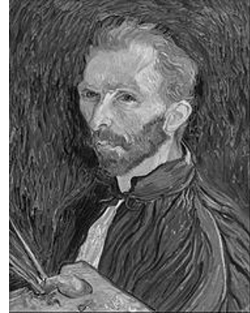
![]() A bunch of people who were dumb enough to study art and smart enough to get a Master's Degree in it, plus a few who went on to obtain their doctorates, thus condemning themselves to teaching Art History for the rest of their lives. For the ultimate college art teacher, rent The Eiger Sanction.
A bunch of people who were dumb enough to study art and smart enough to get a Master's Degree in it, plus a few who went on to obtain their doctorates, thus condemning themselves to teaching Art History for the rest of their lives. For the ultimate college art teacher, rent The Eiger Sanction.
The job you get after you graduate
![]() You might become a high school art teacher and teach a bunch of talentless miscreants and hoodlums who won't listen to a word you say to go out and vandalize box cars with spray paint. A job in advertising, you say? HAH! Forget it. Marry someone whose dad owns an ad agency instead. Advertising is a field where they want to know who you know, not what you know. They don't care if you graduated Kindergarten. Can't you tell from looking at ads? The only talented person ever in the advertising field was Andy Warhol, and he hated it. You want to be an artist and have your crap hanging in fine galleries? Marry a gallery owner or an art critic. You want to make a lot of money? Look at Van Gogh , you say, his paintings sell for millions! As your will learn in Art History, poor Vincent only sold one painting in his entire life, to his brother, for about five dollars in today's money.
You might become a high school art teacher and teach a bunch of talentless miscreants and hoodlums who won't listen to a word you say to go out and vandalize box cars with spray paint. A job in advertising, you say? HAH! Forget it. Marry someone whose dad owns an ad agency instead. Advertising is a field where they want to know who you know, not what you know. They don't care if you graduated Kindergarten. Can't you tell from looking at ads? The only talented person ever in the advertising field was Andy Warhol, and he hated it. You want to be an artist and have your crap hanging in fine galleries? Marry a gallery owner or an art critic. You want to make a lot of money? Look at Van Gogh , you say, his paintings sell for millions! As your will learn in Art History, poor Vincent only sold one painting in his entire life, to his brother, for about five dollars in today's money.
Lesson 1: The Critique
![]() The ultimate in masochism. Your grade depends on the critique. In the critique, everyone in class exhibits their work, and comments on all of it. How good yours looks depends on how bad theirs looks. Each work is scrutinized and ruthlessly shredded by your competitors, whose grades depend on how good their work looks compared to yours. These people are mostly talentless losers, not unlike yourself, who desperately want their work placed somewhere where someone might see it, just like you and Vincent.
The ultimate in masochism. Your grade depends on the critique. In the critique, everyone in class exhibits their work, and comments on all of it. How good yours looks depends on how bad theirs looks. Each work is scrutinized and ruthlessly shredded by your competitors, whose grades depend on how good their work looks compared to yours. These people are mostly talentless losers, not unlike yourself, who desperately want their work placed somewhere where someone might see it, just like you and Vincent.
![]() To survive this ordeal, keep your work covered until nearly everyone has their work displayed. Place yours prominently next to the worst piece of crap in the room. While everyone is ripping each other to shreds with pompous, empty, multi-syllable phrases, translate what they say into plain English, which will demonstrate to the instructor that you, unlike they, actually understand this gobbledygook. Praise everyone's work with backhanded compliments in such a way that the teacher knows that you know it's crap, while the other students think you're complimenting their work.
Beat everyone to the punch by being merciless about your own work, especially if you've outdone yourself and have actually produced something that doesn't suck. The teacher knows what you've done right; show him/her/it that you know what you've done wrong.
To survive this ordeal, keep your work covered until nearly everyone has their work displayed. Place yours prominently next to the worst piece of crap in the room. While everyone is ripping each other to shreds with pompous, empty, multi-syllable phrases, translate what they say into plain English, which will demonstrate to the instructor that you, unlike they, actually understand this gobbledygook. Praise everyone's work with backhanded compliments in such a way that the teacher knows that you know it's crap, while the other students think you're complimenting their work.
Beat everyone to the punch by being merciless about your own work, especially if you've outdone yourself and have actually produced something that doesn't suck. The teacher knows what you've done right; show him/her/it that you know what you've done wrong.
![]() Smile smugly when you're ripped. Let your face say HA! It worked! They HATE it! (See Insulting an Art Student and Art History, below)
Smile smugly when you're ripped. Let your face say HA! It worked! They HATE it! (See Insulting an Art Student and Art History, below)
![]() Lastly, be an attractive woman with large breasts. The heterosexual men and the lesbians will all be trying to get in your pants and won't be hard on your work, the homosexual men will be afraid of being thought of as misogynistic, and the heterosexual women will dismiss you completely as a total, talentless airhead. This is the only place they won't think of you as a threat.
Lastly, be an attractive woman with large breasts. The heterosexual men and the lesbians will all be trying to get in your pants and won't be hard on your work, the homosexual men will be afraid of being thought of as misogynistic, and the heterosexual women will dismiss you completely as a total, talentless airhead. This is the only place they won't think of you as a threat.
Insults for the art student (see The Critique, above)
![]() Gee, that's really nice! Nice is the worst insult you can give to an artist (See Art History, below).
Gee, that's really nice! Nice is the worst insult you can give to an artist (See Art History, below).
![]() Call a sculpture a statue . Besides nice , statue is the worst thing you can call a sculptor's work. The only person who hates statue worse than a sculptor is an actor.
Call a sculpture a statue . Besides nice , statue is the worst thing you can call a sculptor's work. The only person who hates statue worse than a sculptor is an actor.
![]() Call a painting a picture . Go ahead, show your ignorance!
Call the work pretty . This is an insult to every artist except Audrey Flack.
Call a painting a picture . Go ahead, show your ignorance!
Call the work pretty . This is an insult to every artist except Audrey Flack.
![]() Those of you who are art students or have been art students understand this. Those who aren't have probably hit the back button (or the get me the hell out of here right now button) already. For those of you non-art students who've stayed with me (i.e., so stoned out of your mind that even this is entertaining even though you don't understand a bit of it), although the original purpose of art was decoration, it no longer is. Decorative art is considered by those who know and understand art to be an oxymoron. Art stimulates the mind, the brain, the senses, or better yet, all three at once. If it doesn't make you think and/or feel, it isn't art. See See Art History, below.
Those of you who are art students or have been art students understand this. Those who aren't have probably hit the back button (or the get me the hell out of here right now button) already. For those of you non-art students who've stayed with me (i.e., so stoned out of your mind that even this is entertaining even though you don't understand a bit of it), although the original purpose of art was decoration, it no longer is. Decorative art is considered by those who know and understand art to be an oxymoron. Art stimulates the mind, the brain, the senses, or better yet, all three at once. If it doesn't make you think and/or feel, it isn't art. See See Art History, below.
Art History, or Who the hell is this Vincent guy, anyway?
![]() In the beginning, some ignorant savage discovered that a burned stick made marks. After he discovered that spoiled grapes and some kinds of poisonous plants made him feel really funny without actually killing him, he discovered that sometimes those marks could look like more than marks.
In the beginning, some ignorant savage discovered that a burned stick made marks. After he discovered that spoiled grapes and some kinds of poisonous plants made him feel really funny without actually killing him, he discovered that sometimes those marks could look like more than marks.
![]() Somewhere around the same time, some other ignorant savage discovered that the spoiled berries she was gathering also made marks, and these were in color! WOW, look at the colors! These two got together, smoked some poisonous plants and drank some spoiled berry juice and procreated some more ignorant savages. These two ignorant savages became medicine men and witch doctors , known to us who live tens of thousands of years later as politicians. Bill never inhaled. Oxygen deprivation does weird things to the brain.
Somewhere around the same time, some other ignorant savage discovered that the spoiled berries she was gathering also made marks, and these were in color! WOW, look at the colors! These two got together, smoked some poisonous plants and drank some spoiled berry juice and procreated some more ignorant savages. These two ignorant savages became medicine men and witch doctors , known to us who live tens of thousands of years later as politicians. Bill never inhaled. Oxygen deprivation does weird things to the brain.
![]() Later, the biggest and baddest of each group of ignorant savages beat the bejeebers out of everyone else, took their stuff and declared that everything they could see for as far as they could walk was theirs and if anybody had anything bad to say about this they were going to take a real long nap under the dirt. Nobody complained much, at last nobody with much sense. These jerks were known as kings , and some of the less unenlightened ones let those who could make marks that looked like something other than marks make marks instead of working. Note that the German currency is known as the mark .
Later, the biggest and baddest of each group of ignorant savages beat the bejeebers out of everyone else, took their stuff and declared that everything they could see for as far as they could walk was theirs and if anybody had anything bad to say about this they were going to take a real long nap under the dirt. Nobody complained much, at last nobody with much sense. These jerks were known as kings , and some of the less unenlightened ones let those who could make marks that looked like something other than marks make marks instead of working. Note that the German currency is known as the mark .
![]() Some four to ten thousand years (the figure is disputed by those who don't know for sure, meaning everybody) before a guy got nailed to a cross for not stealing an ass (go figure), one of these incestuous Egyptian kings decided that he wanted a really nice grave. Prehistorians (or archaeologists ) claim that it really had something to do with the economy instead of the fact that the guy was stupid and crazy because his father was also his uncle. Anyway, this prehistoric era is known as the dawn of post-prehistoric art.
Some four to ten thousand years (the figure is disputed by those who don't know for sure, meaning everybody) before a guy got nailed to a cross for not stealing an ass (go figure), one of these incestuous Egyptian kings decided that he wanted a really nice grave. Prehistorians (or archaeologists ) claim that it really had something to do with the economy instead of the fact that the guy was stupid and crazy because his father was also his uncle. Anyway, this prehistoric era is known as the dawn of post-prehistoric art.

![]() After this civilization (run by people who called their dad both Dad and Uncle) perished (see the Old Testament for details; hey, it's documented, if you don't believe witnesses you probably think Elvis is alive and the moon landing was a hoax), the Greeks (Sodom wasn't in Greece but don't tell that to a Greek) built a civilization of their own. These folks (Aristotle, for one) kind of figured stuff out without the benefit of modern science, much like our present day politicians. They brought art to a high not seen since the Egyptians, even without all that gold. About the time their civilization bit the dust, the Romans rose (at least the male Romans), famous for their drunken orgies. The poor Jews still weren't over what the Egyptians had done to them.
After this civilization (run by people who called their dad both Dad and Uncle) perished (see the Old Testament for details; hey, it's documented, if you don't believe witnesses you probably think Elvis is alive and the moon landing was a hoax), the Greeks (Sodom wasn't in Greece but don't tell that to a Greek) built a civilization of their own. These folks (Aristotle, for one) kind of figured stuff out without the benefit of modern science, much like our present day politicians. They brought art to a high not seen since the Egyptians, even without all that gold. About the time their civilization bit the dust, the Romans rose (at least the male Romans), famous for their drunken orgies. The poor Jews still weren't over what the Egyptians had done to them.
![]() During the early part of the Greek civilization there was another culture, the Minoans, who produced stunning works of beauty and grace, and are thought to have been wiped out by an explosive volcano. It is also believed that this same explosion caused a tidal wave that caused the parting of the Red Sea, just in time for the Jews to get across and drown a bunch of mean guys that were chasing them with big knives.
During the early part of the Greek civilization there was another culture, the Minoans, who produced stunning works of beauty and grace, and are thought to have been wiped out by an explosive volcano. It is also believed that this same explosion caused a tidal wave that caused the parting of the Red Sea, just in time for the Jews to get across and drown a bunch of mean guys that were chasing them with big knives.

![]() Meanwhile, my ancestors were painting themselves blue and worshiping trees. Funny what spoiled berries will do! When they were a little more sober, if not completely sane, they were building the world's first PC, known to us as Stonehenge . The hardware was fairly simple, but programming it wiped out their culture completely (the YzeroK problem; they were too stupid, cheap and shortsighted to use more than one digit for date calculations).
Meanwhile, my ancestors were painting themselves blue and worshiping trees. Funny what spoiled berries will do! When they were a little more sober, if not completely sane, they were building the world's first PC, known to us as Stonehenge . The hardware was fairly simple, but programming it wiped out their culture completely (the YzeroK problem; they were too stupid, cheap and shortsighted to use more than one digit for date calculations).
![]() Of course, after the Romans built their famous roads, Visigoths used those roads to come for a visit. Civilization as we know it came to an end.
Of course, after the Romans built their famous roads, Visigoths used those roads to come for a visit. Civilization as we know it came to an end.
![]() A thousand bloody and pestilence filled years or so later, give or take a couple of centuries, after the Visigoths paid their nice visit to the Romans, the Renaissance began. Art and Science started to be reborn, and we actually know some of the artists' names. Artists were known as artisans; well, not really, since English as we know it wasn't spoken, but that's what the art historians teach so I'll repeat it here. They weren't superstars like the artists of the twentieth century, such as Pablo Picasso, Andy Warhol, or O.J. Simpson. They didn't get paid much (Except that brown noser Leonardo), even the ones who were well known in their time.
A thousand bloody and pestilence filled years or so later, give or take a couple of centuries, after the Visigoths paid their nice visit to the Romans, the Renaissance began. Art and Science started to be reborn, and we actually know some of the artists' names. Artists were known as artisans; well, not really, since English as we know it wasn't spoken, but that's what the art historians teach so I'll repeat it here. They weren't superstars like the artists of the twentieth century, such as Pablo Picasso, Andy Warhol, or O.J. Simpson. They didn't get paid much (Except that brown noser Leonardo), even the ones who were well known in their time.
![]() The people of this time had discovered the ancient Romans and Greeks and said Wow, this crap is pretty good! How the hell did they do that?
The people of this time had discovered the ancient Romans and Greeks and said Wow, this crap is pretty good! How the hell did they do that?
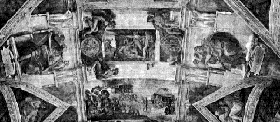
![]() Some of them got pretty good themselves. Michelangelo Buonarroti nearly went blind painting some pictures on the Pope's ceiling (wasn't that Pope guy really nice?) and carved a bunch of statues of naked men with small penises (the Greek influence) out of big rocks. Jan Vermeer invented oil paint, making art theft much easier. Leonardo Da Vinci made a few bucks painting pictures while trying real hard to be Orville Wright.
Then, as now, only the rich or boring had access to fine art.
A Library was any building with a book in it. Books were chained to the walls of these buildings. So were people (usually not in libraries, though). Not content with ruining things in Europe, the Europeans sent their worst politically connected criminals to Australia.
Some of them got pretty good themselves. Michelangelo Buonarroti nearly went blind painting some pictures on the Pope's ceiling (wasn't that Pope guy really nice?) and carved a bunch of statues of naked men with small penises (the Greek influence) out of big rocks. Jan Vermeer invented oil paint, making art theft much easier. Leonardo Da Vinci made a few bucks painting pictures while trying real hard to be Orville Wright.
Then, as now, only the rich or boring had access to fine art.
A Library was any building with a book in it. Books were chained to the walls of these buildings. So were people (usually not in libraries, though). Not content with ruining things in Europe, the Europeans sent their worst politically connected criminals to Australia.

![]() While all this was going on, the Asians and Americans were building civilizations, inventing computers (The Mayan's computer, like our own, stops at the end of the 20th century, but it didn't matter nearly as much to them as to us, since they're all dead) and gunpowder, and, of course, destroying their own civilizations again and again in the process. Aren't computers and gunpowder fun?
While all this was going on, the Asians and Americans were building civilizations, inventing computers (The Mayan's computer, like our own, stops at the end of the 20th century, but it didn't matter nearly as much to them as to us, since they're all dead) and gunpowder, and, of course, destroying their own civilizations again and again in the process. Aren't computers and gunpowder fun?
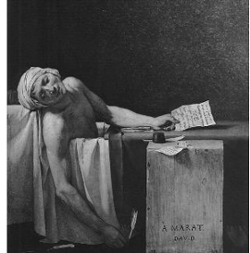
![]() A couple of hundred years later, the peasants were revolting. I could have told you that , the aristocracy said; but they were pretty stupid, and didn't know that what was meant was that revolution was brewing, not that the peasants weren't pleasant. The Queen of France, when she heard that the peasants had no bread, said let them eat cake. The King of England, when he heard that the colonists were unhappy with taxes, raised the taxes on tea and passed a law making it illegal not to drink tea. In France, then considered the art capital of the world , Neoclassicism (meaning that painters and sculptors were still in awe of the Romans and Greeks) was all the rage. The French revolution was blamed by some art historians on some of this neoclassical art (see the image above). In the English colonies, nothing was blamed on art, since all the homegrown stuff was really crap, and they were too busy growing hemp and plotting revolution, much like the hippies of the 1960s. They had long hair, too.
A couple of hundred years later, the peasants were revolting. I could have told you that , the aristocracy said; but they were pretty stupid, and didn't know that what was meant was that revolution was brewing, not that the peasants weren't pleasant. The Queen of France, when she heard that the peasants had no bread, said let them eat cake. The King of England, when he heard that the colonists were unhappy with taxes, raised the taxes on tea and passed a law making it illegal not to drink tea. In France, then considered the art capital of the world , Neoclassicism (meaning that painters and sculptors were still in awe of the Romans and Greeks) was all the rage. The French revolution was blamed by some art historians on some of this neoclassical art (see the image above). In the English colonies, nothing was blamed on art, since all the homegrown stuff was really crap, and they were too busy growing hemp and plotting revolution, much like the hippies of the 1960s. They had long hair, too.
![]() I have completely glossed over the Victorians, like Renoir, Titian (honest, that was really his name), etc., who liked to paint obscene pictures of fat naked women swinging on swing sets, laying on couches, and doing other silly things, and some of the art from Holland, including whats-his-name, who painted dark, gloomy pictures of ugly and/or dead people.
I have completely glossed over the Victorians, like Renoir, Titian (honest, that was really his name), etc., who liked to paint obscene pictures of fat naked women swinging on swing sets, laying on couches, and doing other silly things, and some of the art from Holland, including whats-his-name, who painted dark, gloomy pictures of ugly and/or dead people.
![]() In the late nineteenth century, the galleries were filled with some real sucky crap that is considered crap even today. You won't see any of them in any museum, and may be unlucky enough to see one or two in an art history class as a good example of what art isn't. The painters that you will recognize weren't being hung; they were too busy getting big red R s for rejected from this art show stamped on the back of their paintings so nobody would dare offend the art establishment by trying to sell one. We will go into some of them in detail here.
In the late nineteenth century, the galleries were filled with some real sucky crap that is considered crap even today. You won't see any of them in any museum, and may be unlucky enough to see one or two in an art history class as a good example of what art isn't. The painters that you will recognize weren't being hung; they were too busy getting big red R s for rejected from this art show stamped on the back of their paintings so nobody would dare offend the art establishment by trying to sell one. We will go into some of them in detail here.
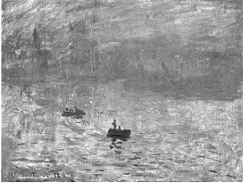
![]() Art as we know it was being born in this period; art for art's sake (yeah, like they would have been offended if you offered them money) which explored light, color, form, abstraction, and all of the elements that make the average layman say really lame things like my five year old could do better than that and but what is it?
Art as we know it was being born in this period; art for art's sake (yeah, like they would have been offended if you offered them money) which explored light, color, form, abstraction, and all of the elements that make the average layman say really lame things like my five year old could do better than that and but what is it?
![]() There were several different schools , meaning kinds of painting, not where they learned to do it. The first were the impressionists, such as Renoir, who I lied about earlier. Well, it was the Victorian era but he was known as an impressionist, with such greats as child with a whip , Head of a dog , and Bather arranging her hair . Manet painted such memorable works as The queer musician and Fruit on a table . Edward Degas painted After the bath and Woman Drying Herself . Claud Monet painted the Luncheon on the Grass picture, famous for its big red R stamped on the back, Lady in the Garden at Sainte-Adresse , a nice picture, it's really pretty, and Poppy Field , which may give you an idea of where some of their inspiration came from.
There were several different schools , meaning kinds of painting, not where they learned to do it. The first were the impressionists, such as Renoir, who I lied about earlier. Well, it was the Victorian era but he was known as an impressionist, with such greats as child with a whip , Head of a dog , and Bather arranging her hair . Manet painted such memorable works as The queer musician and Fruit on a table . Edward Degas painted After the bath and Woman Drying Herself . Claud Monet painted the Luncheon on the Grass picture, famous for its big red R stamped on the back, Lady in the Garden at Sainte-Adresse , a nice picture, it's really pretty, and Poppy Field , which may give you an idea of where some of their inspiration came from.
![]() The impressionists were trying to catch the light , the way a scene looked like in an instant that the light was unusual, which explains why so many of their paintings look fuzzy and/or sketchy. Pretty avant-garde for the time, but if you try to do it they'll say it's real lame.
The impressionists were trying to catch the light , the way a scene looked like in an instant that the light was unusual, which explains why so many of their paintings look fuzzy and/or sketchy. Pretty avant-garde for the time, but if you try to do it they'll say it's real lame.
![]() Then there were the post impressionists, who painted pictures of posts. Well, okay, that's a lie, too. They were Post Impressionists because by the time they found out they weren't ever going to be hung in the fancy high priced galleries Impressionism was already starting to be pass , so they painted pretty much the same way and gave it a new name. Two of the most infamous were Vincent Van Gogh (So that's who Vincent was) and Paul Cezanne. They were roommates at one time, and Cezanne hated Van Gogh's guts. Nobody except a few other artists ever heard of Van Gogh at the time, and all of them thought his stuff sucked.
Then there were the post impressionists, who painted pictures of posts. Well, okay, that's a lie, too. They were Post Impressionists because by the time they found out they weren't ever going to be hung in the fancy high priced galleries Impressionism was already starting to be pass , so they painted pretty much the same way and gave it a new name. Two of the most infamous were Vincent Van Gogh (So that's who Vincent was) and Paul Cezanne. They were roommates at one time, and Cezanne hated Van Gogh's guts. Nobody except a few other artists ever heard of Van Gogh at the time, and all of them thought his stuff sucked.
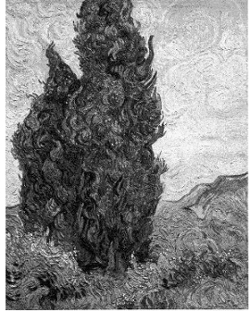
![]() Gaughan is known for some of his primitive looking pictures of unclad and scantily clad ugly women, one of whom was his wife. Gaughan used bright, garish, clashing colors, much like I was criticized for in critiques, which are now widely used in advertising by dimwits who don't know any better or care.
Gaughan is known for some of his primitive looking pictures of unclad and scantily clad ugly women, one of whom was his wife. Gaughan used bright, garish, clashing colors, much like I was criticized for in critiques, which are now widely used in advertising by dimwits who don't know any better or care.
![]() Van Gogh was a real nut case, a homosexual alcoholic drug abuser who cut off his ear and mailed it to Gaughan as an indication of his affection. Limp-wristed Vincent only sold one painting in his entire life, to his brother, for a pittance, as payback for some money he owed his brother. This loser painted some incredibly stunning paintings that must be seen in the flesh to be appreciated. Actually, all of the paintings mentioned here must be seen to be appreciated. Most of them are really huge, and there's no way the detail and color can be reproduced in an obscenely expensive art book, which this isn't, let alone on a computer screen. One of Van Gogh's paintings is of a branch of a blooming dogwood tree. Up close, it is completely abstract, and you can't tell what it's a picture of. From across a very large room it stands out in stunning detail, and appears to be a real branch with real flowers standing out about three feet from the canvas.
Van Gogh was a real nut case, a homosexual alcoholic drug abuser who cut off his ear and mailed it to Gaughan as an indication of his affection. Limp-wristed Vincent only sold one painting in his entire life, to his brother, for a pittance, as payback for some money he owed his brother. This loser painted some incredibly stunning paintings that must be seen in the flesh to be appreciated. Actually, all of the paintings mentioned here must be seen to be appreciated. Most of them are really huge, and there's no way the detail and color can be reproduced in an obscenely expensive art book, which this isn't, let alone on a computer screen. One of Van Gogh's paintings is of a branch of a blooming dogwood tree. Up close, it is completely abstract, and you can't tell what it's a picture of. From across a very large room it stands out in stunning detail, and appears to be a real branch with real flowers standing out about three feet from the canvas.
![]() His last three works were of the same corn field. The first was very detailed, using a very small brush and must have taken forever to paint. The second was much sloppier and painted with the kind of brush most people use to paint window trim with. The last is a finger painting. After he painted the third version, he sat down in the cornfield he had just painted and shot himself.
His last three works were of the same corn field. The first was very detailed, using a very small brush and must have taken forever to paint. The second was much sloppier and painted with the kind of brush most people use to paint window trim with. The last is a finger painting. After he painted the third version, he sat down in the cornfield he had just painted and shot himself.
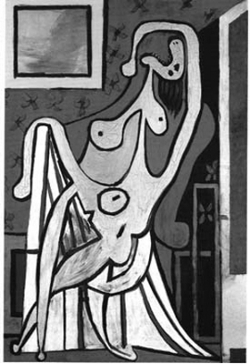
![]() The opening of the twentieth century brought even weirder stuff. The cubists attempted to portray four dimensional images on a two dimensional surface. The most well known of these was Pablo Picasso, whose early work wasn't cubistic at all, but quite realistic. Laymen who see Picasso's early work say That's Picasso? When did he learn to paint?
The opening of the twentieth century brought even weirder stuff. The cubists attempted to portray four dimensional images on a two dimensional surface. The most well known of these was Pablo Picasso, whose early work wasn't cubistic at all, but quite realistic. Laymen who see Picasso's early work say That's Picasso? When did he learn to paint?
![]() The Surrealists Attempted to make sense of their dreams, or what they would like you to think were their dreams. Surrealism was first invented by German writers, and visual artists, always looking for something different, stole the idea.
The Surrealists Attempted to make sense of their dreams, or what they would like you to think were their dreams. Surrealism was first invented by German writers, and visual artists, always looking for something different, stole the idea.
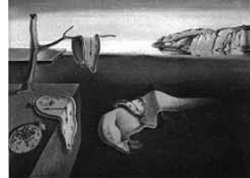
![]() The most famous Surrealist was Salvador Dali, a Spanish guy who was nearly as nutty as Van Gogh, although he had better reason to be out of his tiny little mind. Dali's older brother was also named Salvador (Hi, I'm Larry, this is my brother Darryl, and this is my other brother Darryl). Salvador is Spanish for savior , as in Our lord and savior Jesus Christ . After the older brother died, Dali was born, and his parents, obviously at least as nutty as their offspring, named the second baby Salvador also, thinking the second baby was the reincarnation of the first baby. Salvador was led to believe that he was Christ, or at least the Anti-Christ. This loony tunes is most famous for the picture illustrated above, the one with the melted clocks. Another of his paintings has some very photorealistic images of dead flies on it... no, wait, they're real flies stuck on the canvas! Dali had himself hung from a flying airplane by his mustache. Even Van Gogh wasn't crazy enough to do something like that.
The most famous Surrealist was Salvador Dali, a Spanish guy who was nearly as nutty as Van Gogh, although he had better reason to be out of his tiny little mind. Dali's older brother was also named Salvador (Hi, I'm Larry, this is my brother Darryl, and this is my other brother Darryl). Salvador is Spanish for savior , as in Our lord and savior Jesus Christ . After the older brother died, Dali was born, and his parents, obviously at least as nutty as their offspring, named the second baby Salvador also, thinking the second baby was the reincarnation of the first baby. Salvador was led to believe that he was Christ, or at least the Anti-Christ. This loony tunes is most famous for the picture illustrated above, the one with the melted clocks. Another of his paintings has some very photorealistic images of dead flies on it... no, wait, they're real flies stuck on the canvas! Dali had himself hung from a flying airplane by his mustache. Even Van Gogh wasn't crazy enough to do something like that.
![]() Some of Dali's works are disturbing, hell they're all nutzo. This guy was downright weird. This guy, who you definitely wouldn't want your daughter (let alone your son) to date, painted some beautiful stuff, none of which makes any sense to anybody except another lunatic. Terrified of dying, he found religion in his later years and painted huge religious pictures that are as crazy, weird and beautiful as the early stuff. When you go to Florida to see Mickey Mouse and try and get a job making cartoons for the kiddies, be sure to go to Tampa and see the Dali museum.
Some of Dali's works are disturbing, hell they're all nutzo. This guy was downright weird. This guy, who you definitely wouldn't want your daughter (let alone your son) to date, painted some beautiful stuff, none of which makes any sense to anybody except another lunatic. Terrified of dying, he found religion in his later years and painted huge religious pictures that are as crazy, weird and beautiful as the early stuff. When you go to Florida to see Mickey Mouse and try and get a job making cartoons for the kiddies, be sure to go to Tampa and see the Dali museum.

![]() In the 1920s another school of artists sprung up, and this bunch was also rejected by the art establishment. If you're starting to get a clue, well, good for you. This art is known as Dada (Note that there is an art museum in Chicago known as MOMA). Dada was anti art art (Huh??), a total rejection of the art establishment. Marcel Duchamp hung a urinal from the wall as a statement about the art establishment, and critics praised it for its color and form. A dada exhibit featuring a woman reading poetry wearing nothing but a hat was busted by the local constables. There is some dada to the left.
In the 1920s another school of artists sprung up, and this bunch was also rejected by the art establishment. If you're starting to get a clue, well, good for you. This art is known as Dada (Note that there is an art museum in Chicago known as MOMA). Dada was anti art art (Huh??), a total rejection of the art establishment. Marcel Duchamp hung a urinal from the wall as a statement about the art establishment, and critics praised it for its color and form. A dada exhibit featuring a woman reading poetry wearing nothing but a hat was busted by the local constables. There is some dada to the left.
![]() By the end of the twentieth century, things were changing at such a rapid pace that I would get way too bored to get into all of them with even the most cursory examination, but some of the folks that may or may not be remembered by art historians include Andy Warhol, the shoe salesman turned pop culture icon, Jackson Pollack, who made nice pictures; well, actually he did it by splashing paint on canvasses from usually about six feet away, Audrey Flack, Robert Rauschenberg, Lets see, that guy that made that one picture, you know the one...
By the end of the twentieth century, things were changing at such a rapid pace that I would get way too bored to get into all of them with even the most cursory examination, but some of the folks that may or may not be remembered by art historians include Andy Warhol, the shoe salesman turned pop culture icon, Jackson Pollack, who made nice pictures; well, actually he did it by splashing paint on canvasses from usually about six feet away, Audrey Flack, Robert Rauschenberg, Lets see, that guy that made that one picture, you know the one...
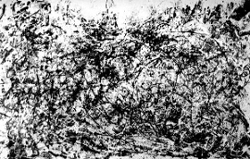
Painting
Color
![]() There are only three of them. They are not the same three you see on your monitor. In painting, the only three colors there are are red, yellow, and blue. At least, they are the only colors that matter, since you can theoretically make all the colors from those three. Theory is often wrong in art.
There are only three of them. They are not the same three you see on your monitor. In painting, the only three colors there are are red, yellow, and blue. At least, they are the only colors that matter, since you can theoretically make all the colors from those three. Theory is often wrong in art.
Your Eyeball
![]() There are theoretically an infinite number if colors, some of which you can actually see. Light bounces off of things right into your eyeball through the part that isn't opaque, called the cornea. A lens focuses the light through this aperture where it lands on what is known as that movie screen thing on the back of the inside of the eye , or TMSTOTBOTE, also known as a retina.
There are theoretically an infinite number if colors, some of which you can actually see. Light bounces off of things right into your eyeball through the part that isn't opaque, called the cornea. A lens focuses the light through this aperture where it lands on what is known as that movie screen thing on the back of the inside of the eye , or TMSTOTBOTE, also known as a retina.
![]() The retina has microscopic rods that can detect brightness, and microscopic cones that detect certain wavelengths, roughly corresponding to magenta, cyan, and yellow. These cones send signals through nerves to the brain, where you actually do all the seeing. Nobody has the faintest idea of how the brain works.
The retina has microscopic rods that can detect brightness, and microscopic cones that detect certain wavelengths, roughly corresponding to magenta, cyan, and yellow. These cones send signals through nerves to the brain, where you actually do all the seeing. Nobody has the faintest idea of how the brain works.
![]() There are an infinite number of colors, but you can only see about four thousand of them. You can make all four thousand of them with just red, blue, and yellow. At least, if you also use black and white. And use warm and cool versions of each of your three colors.
There are an infinite number of colors, but you can only see about four thousand of them. You can make all four thousand of them with just red, blue, and yellow. At least, if you also use black and white. And use warm and cool versions of each of your three colors.
![]() Your first assignment is to make a color wheel using only black and red. And you have to be blindfolded.
Your first assignment is to make a color wheel using only black and red. And you have to be blindfolded.
Design
![]() There are three kinds of design: Good design, bad design, and design that everybody argues whether or not it's good or bad design. You should strive for the third. You will not accomplish it unless you understand both the principles of good design and bad design. For an example of bad design, see The very worst page on the web and webpagesthat-suck.com .
Learn the Golden mean . It was good enough for Leonardo and Michelangelo, it's good enough for you. Unfortunately, it's a mathematical concept which is way too boring for art students. Infoseek lists 902 pages discussing it, if you want to get really bored, look it up. Hey, you have a computer, use it!
There are three kinds of design: Good design, bad design, and design that everybody argues whether or not it's good or bad design. You should strive for the third. You will not accomplish it unless you understand both the principles of good design and bad design. For an example of bad design, see The very worst page on the web and webpagesthat-suck.com .
Learn the Golden mean . It was good enough for Leonardo and Michelangelo, it's good enough for you. Unfortunately, it's a mathematical concept which is way too boring for art students. Infoseek lists 902 pages discussing it, if you want to get really bored, look it up. Hey, you have a computer, use it!
![]() After learning how to use burned sticks and spoiled berries, my attention turned to more modern (and postmodern, and postpostpostmodern) media, such as acrylic polymers, airbrush, and pixels. Art is art. Since the newest art form is electrically stimulated glowing phosphors, further discussion of design will use (yawn) HTML.
After learning how to use burned sticks and spoiled berries, my attention turned to more modern (and postmodern, and postpostpostmodern) media, such as acrylic polymers, airbrush, and pixels. Art is art. Since the newest art form is electrically stimulated glowing phosphors, further discussion of design will use (yawn) HTML.
![]() Here are a few less uninteresting design principles:
Here are a few less uninteresting design principles:
![]() If it's boring, it sucks.
If it's boring, it sucks.
![]() Heavy things fall and light things float. Somehow, the untrained seldom realize this.
Heavy things fall and light things float. Somehow, the untrained seldom realize this.
![]() Keep your audience's eye on the media (see the golden mean and If it's boring it sucks , above).
Keep your audience's eye on the media (see the golden mean and If it's boring it sucks , above).
![]() Yellow on white is very hard to read. Use it if you wish to induce insanity. Yellow on black is readable, but not until the background loads.
Yellow on white is very hard to read. Use it if you wish to induce insanity. Yellow on black is readable, but not until the background loads.
![]() Yellow on black is ugly, unless your ancestors came from Mars or Stroggos.
Yellow on black is ugly, unless your ancestors came from Mars or Stroggos.
![]() If you go far enough back in prehistory, everybody's ancestors came from Africa. At least, that's the prevailing theory. They may even be from Mars.
If you go far enough back in prehistory, everybody's ancestors came from Africa. At least, that's the prevailing theory. They may even be from Mars.
![]() Frames usually make paintings suck less. Frames usually make web pages suck more.
Frames usually make paintings suck less. Frames usually make web pages suck more.
![]() Tables are often useful in sculpture. They are also often useful in HTML.
Tables are often useful in sculpture. They are also often useful in HTML.
![]() Never, EVER, make a web page as long as this one.
In painting, Java is often useful to make a nice brown color, or to stay awake. In HTML design, Java can be used to drive viewers away from your page. Never EVER make that There is a possible security risk window come up unless you don't want anybody except the violently insane to see your page.
To plagiarize, uh, I mean quote one of my instructors (John Adkins Richardson) from his book The Complete book of CarTOONing , which we had to buy or flunk, so I'm finally going to get my money's worth:
Never, EVER, make a web page as long as this one.
In painting, Java is often useful to make a nice brown color, or to stay awake. In HTML design, Java can be used to drive viewers away from your page. Never EVER make that There is a possible security risk window come up unless you don't want anybody except the violently insane to see your page.
To plagiarize, uh, I mean quote one of my instructors (John Adkins Richardson) from his book The Complete book of CarTOONing , which we had to buy or flunk, so I'm finally going to get my money's worth:
![]() I do not for one minute believe that Milton Caniff laid out the composition by any procedure as organized as this, but he might have and The way in which such relationships actually develop on paper is made clearer when they are seen in working drawings. Gil Kane's preliminary layout for his book Blackmark is uncommonly coherent... (page 169)
I do not for one minute believe that Milton Caniff laid out the composition by any procedure as organized as this, but he might have and The way in which such relationships actually develop on paper is made clearer when they are seen in working drawings. Gil Kane's preliminary layout for his book Blackmark is uncommonly coherent... (page 169)
Next: Perspective, color, and a bunch of other junk nobody will read.
1997, reprinted around 2005 at Kuro5hin